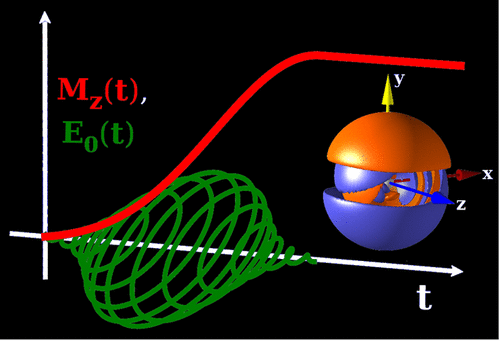当前位置:
X-MOL 学术
›
ACS Photonics
›
论文详情
Our official English website, www.x-mol.net, welcomes your
feedback! (Note: you will need to create a separate account there.)
Driving Orbital Magnetism in Metallic Nanoparticles through Circularly Polarized Light: A Real-Time TDDFT Study
ACS Photonics ( IF 6.5 ) Pub Date : 2020-07-20 , DOI: 10.1021/acsphotonics.0c00462 Rajarshi Sinha-Roy 1, 2 , Jérôme Hurst 3 , Giovanni Manfredi 4 , Paul-Antoine Hervieux 4
ACS Photonics ( IF 6.5 ) Pub Date : 2020-07-20 , DOI: 10.1021/acsphotonics.0c00462 Rajarshi Sinha-Roy 1, 2 , Jérôme Hurst 3 , Giovanni Manfredi 4 , Paul-Antoine Hervieux 4
Affiliation

|
Transfer of angular momentum from helicity-controlled laser fields to a nonmagnetic electronic system can lead to the creation of magnetization. The underlying mechanism in metallic nanoparticles has been studied using different theoretical approaches. However, an understanding of the dynamics using an orbital-based quantum-mechanical method within the many-body theoretical framework is still due. To this end, the real-time formulation of time-dependent, density-functional theory is used to study induced orbital magnetism in metallic nanoparticles (clusters) excited by circularly polarized light. The nanoparticles are described by a spherical jellium model on a real-space grid. The polarized laser field gives rise to an angular momentum and, hence, a magnetic moment, which is maximum at the surface plasmon frequency of the nanoparticle, revealing that this is a resonant plasmonic effect. The primary contribution to the magnetic moment comes from surface currents generated by the plasmonic field, although some bulk contributions due to the quantum-mechanical nature of the system (Friedel oscillations) still persist. We compare several nanoparticles of K, Na, and Au having the same size and excited at their respective plasmon frequencies and show that the generated magnetic moment per energy pumped into the system is maximum for K and minimum for Au. A similar trend is observed for nanoparticles of the same chemical species but different sizes.
中文翻译:

通过圆偏振光驱动金属纳米粒子中的轨道磁性:实时TDDFT研究
角动量从螺旋度控制的激光场到非磁性电子系统的转移会导致磁化。已经使用不同的理论方法研究了金属纳米颗粒的潜在机理。但是,仍然需要在多体理论框架内使用基于轨道的量子力学方法来了解动力学。为此,使用时变的密度泛函理论的实时表示法来研究圆偏振光激发的金属纳米粒子(团簇)中的感应轨道磁性。纳米粒子通过在真实空间网格上的球形胶体模型描述。极化的激光场会产生角动量,从而产生磁矩,该磁矩在纳米粒子的表面等离激元频率处最大,揭示这是共振等离子体激元效应。尽管由于系统的量子力学性质(Friedel振荡)仍会产生一些体积贡献,但对磁矩的主要贡献来自于等离子体场产生的表面电流。我们比较了K,Na和Au的几个纳米粒子,它们具有相同的大小,并在各自的等离激元频率下激发,并且表明泵入系统的每能量产生的磁矩对于K最大,对于Au最小。对于相同化学物种但尺寸不同的纳米颗粒,观察到相似的趋势。尽管由于系统的量子力学性质(Friedel振荡)仍存在一些体积贡献。我们比较了K,Na和Au的几个纳米粒子,它们具有相同的大小,并在各自的等离激元频率下激发,并且表明泵入系统的每能量产生的磁矩对于K最大,对于Au最小。对于相同化学物种但尺寸不同的纳米颗粒,观察到相似的趋势。尽管由于系统的量子力学性质(Friedel振荡)仍存在一些体积贡献。我们比较了K,Na和Au的几个纳米粒子,它们具有相同的大小,并在各自的等离激元频率下激发,并且表明泵入系统的每能量产生的磁矩对于K最大,对于Au最小。对于相同化学物种但尺寸不同的纳米颗粒,观察到相似的趋势。
更新日期:2020-09-16
中文翻译:

通过圆偏振光驱动金属纳米粒子中的轨道磁性:实时TDDFT研究
角动量从螺旋度控制的激光场到非磁性电子系统的转移会导致磁化。已经使用不同的理论方法研究了金属纳米颗粒的潜在机理。但是,仍然需要在多体理论框架内使用基于轨道的量子力学方法来了解动力学。为此,使用时变的密度泛函理论的实时表示法来研究圆偏振光激发的金属纳米粒子(团簇)中的感应轨道磁性。纳米粒子通过在真实空间网格上的球形胶体模型描述。极化的激光场会产生角动量,从而产生磁矩,该磁矩在纳米粒子的表面等离激元频率处最大,揭示这是共振等离子体激元效应。尽管由于系统的量子力学性质(Friedel振荡)仍会产生一些体积贡献,但对磁矩的主要贡献来自于等离子体场产生的表面电流。我们比较了K,Na和Au的几个纳米粒子,它们具有相同的大小,并在各自的等离激元频率下激发,并且表明泵入系统的每能量产生的磁矩对于K最大,对于Au最小。对于相同化学物种但尺寸不同的纳米颗粒,观察到相似的趋势。尽管由于系统的量子力学性质(Friedel振荡)仍存在一些体积贡献。我们比较了K,Na和Au的几个纳米粒子,它们具有相同的大小,并在各自的等离激元频率下激发,并且表明泵入系统的每能量产生的磁矩对于K最大,对于Au最小。对于相同化学物种但尺寸不同的纳米颗粒,观察到相似的趋势。尽管由于系统的量子力学性质(Friedel振荡)仍存在一些体积贡献。我们比较了K,Na和Au的几个纳米粒子,它们具有相同的大小,并在各自的等离激元频率下激发,并且表明泵入系统的每能量产生的磁矩对于K最大,对于Au最小。对于相同化学物种但尺寸不同的纳米颗粒,观察到相似的趋势。











































 京公网安备 11010802027423号
京公网安备 11010802027423号